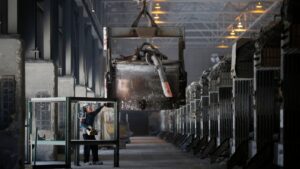In the 1960s, Roy Calne, professor of surgery at Cambridge University, was captivated by the emerging new science of transplantation to help those with kidney and liver failure.
Calne, who has died aged 93, became Britain’s leading transplant surgeon and researcher and achieved a number of firsts, including the first liver transplant in Europe in 1968, the world’s first liver, heart and lung transplant in 1987 (with John Wallwork) and the world’s first successful “organ group” transplant (stomach, intestine, pancreas, liver and kidney) in 1994.
The game changer and his greatest achievement was his use of drugs, including cyclosporine, to suppress the immune system and prevent organ rejection. By 1977, cyclosporine had increased the chance of surviving a year after a kidney transplant to about 80%, paving the way for transplant medicine to become mainstream and a major expansion in the number of transplant units worldwide.
Calne’s interest in transplants began in 1950 when, as a medical student, he was shocked to learn that a young patient on his ward who was the same age as himself would die of kidney failure in two weeks. He asked why they could not save the patient’s life with a new kidney. He had never seen a transplant operation, but he thought it would not be technically difficult to detach the kidney from its connecting vein, ureter and artery and graft a new one. His consultant dismissed the suggestion as impossibly naive. With so little known about the immune system, donor organs are almost always rejected.
In 1957, while studying for the fellowship examination at the Royal College of Surgeons, Calne took a job at Oxford University as an anatomy demonstrator. There he heard the biologist Peter Medawar talk about the latest research on immunological tolerance.
Medawar injected newborn mice with cells from another mouse. The immune systems of the host mice were still developing and would tolerate the cells from the donor, so that if you later gave them a skin graft from the donor mouse, it would be accepted. Calne then asked if there was any practical application for transplant patients and Medawar replied, “Absolutely none.”
Undaunted, Calne, who in 1958 became a surgeon at the Royal Free Hospital London, determined that it must be possible to transplant organs and used his spare time to experiment with kidney transplants in animals. He initially used radiation to prevent their immune system from rejecting the donor organ, but it was too toxic, so he tried the drug 6-mercaptopurine, with limited success.
He kept in touch with Medawar, who helped him get a Harkness Fellowship in 1960 at the Peter Bent Brigham Hospital in Boston to study with Francis Moore and Joseph Murray, the leading transplant surgeons of the day. In 1954, Murray successfully performed the world’s first human kidney transplant – the donor and recipient were identical twins, who overcame the organ rejection problem.
While in the US, Calne continued to experiment with animals (a collie named Lollipop lived six months after a kidney transplant) and also met the scientists George Hitchings and Gertrude Elion of the Burroughs Wellcome laboratory, which created the immunosuppressant drug azathioprine, which produced good results when used with steroid drugs. When Calne returned to London, he took a job at St Mary’s Hospital, where 20 patients had died after unsuccessful kidney transplants. They were given X-rays to cause immunosuppression, but at Calne’s insistence, future patients were treated with azathioprine.
In 1965 Calne became both professor of surgery at Cambridge and a consultant at Addenbrooke’s Hospital, where he remained for 33 years. He started a kidney transplant program and set up a tissue typing laboratory and blood bank, operating on his first kidney transplant patient in 1966.
When a woman with a malignant growth on her liver was referred to Addenbrooke’s in 1968, he decided to offer her a transplant. His hospital colleagues opposed the operation as too risky, but Moore, his former mentor from the USA, happened to be in Cambridge and supported him, assisting him with what was the first liver transplant in Europe.
Encouraged by this, Calne formed a partnership with the hepatologist Roger Williams of King’s College Hospital in London, in which he performed the operation and Williams cared for the patients. Initially, they and the recipient of the liver would have to travel to the hospital where the donor died, which could be anywhere in the country, and there was only a small window of opportunity while the liver was viable. The situation improved greatly in the 1970s with techniques to keep the liver in good condition and with more blood banks and specialized nursing staff.
But the biggest improvement came with the use of cyclosporine. Employees at the Swiss chemical company Sandoz were encouraged to collect soil samples when they traveled that could be analyzed for new organisms that might have a medicinal use. A fungus found in this way gave rise to the immunosuppressant cyclosporine.
In 1977, Calne heard about it and offered to test it in animal experiments. His team found that they got particularly good results when it was dissolved in olive oil, and went on to test it in humans. It increased the chances of surviving a year after a kidney transplant from 50% to 80%. The team also pioneered the use of other immunosuppressive drugs, including rapamycin, 5K506 and Campath 1H.
Calne’s transplant program grew and by the 90s his team was performing more than 100 liver and 80 kidney transplants each year. They even treated children, including Ben Hardwick, who in 1984 was Britain’s youngest liver transplant patient.
As operations became more complex, Calne collaborated with other units and specialties. In 1987, for example, in a joint operation with colleagues in Cambridge at Papworth Hospital, he gave a liver transplant to a woman who had also had a heart and lung transplant.
Calne was born in Richmond, Surrey, the eldest of two sons. His father, Joseph, who was an automotive engineer at Rover, owned a garage and encouraged his son to take engines apart. His mother, Eileen (née Gubbay), was adamant that Roy and her younger son, Donald, should be denied the chance to go to university and Roy said “she was a serious tutor to my younger brother and myself “. Donald later became a leading neurologist in Canada.
Roy was educated at Dulwich Preparatory School in South London, which was evacuated to North Wales during the Second World War, and Lancing College, West Sussex, which was again evacuated to Ludlow, Shropshire. At Lancing he enjoyed nature and life sciences, and kept a flock of 40 pigeons in the attic of the school chapel.
From the age of 12, Calne, who said he was “fascinated by the human engine”, knew he wanted to be a surgeon. When he was 16, he was accepted to study medicine at Guy’s Hospital in London, where his fellow medical students – demobilized soldiers from the Second World War – were almost a decade older than him.
After qualifying, Calne joined the Royal Army Medical Corps in 1953 to do his national service with the Gurkhas. His girlfriend Patsy (Patricia) Whelan, a nurse at Guy’s, also managed to be stationed in the far east with Queen Alexandra’s Royal Nursing Corps and the couple married in Hong Kong in 1956. They would go on to have four daughters and two sons.
From an early age, Calne always enjoyed painting. In 1988 he operated on the distinguished Scottish painter John Bellany, who made 60 portraits of himself in the hospital after his liver transplant. He gave Calne lessons and they painted each other. Painting grew into a tremendously therapeutic hobby for Calne, who painted many of his transplant patients and found that it brought a different, more human quality to the relationship, especially with his child patients. In 1991 he had an exhibition, The Gift of Life, at the Barbican in London.
In 1986 Calne was knighted for services to transplant medicine and in 2014 won the Pride of Britain Lifetime Achievement Award. He continued to be outspoken on topics such as transplant ethics, NHS management and the world’s growing population (writing a book, Too Many People, on the subject published in 1994).
After his retirement from the NHS, he became Professor of Surgery in Singapore. He kept in close contact with other transplant doctors and surgeons around the world, especially the American transplant surgeon Thomas Starzland in 2012, Starzl and Calne shared the Lasker DeBakey Prize (sometimes known as the “pre-Nobel”) for liver transplantation.
Calne is survived by Patsy, their children and his brother, Donald.





